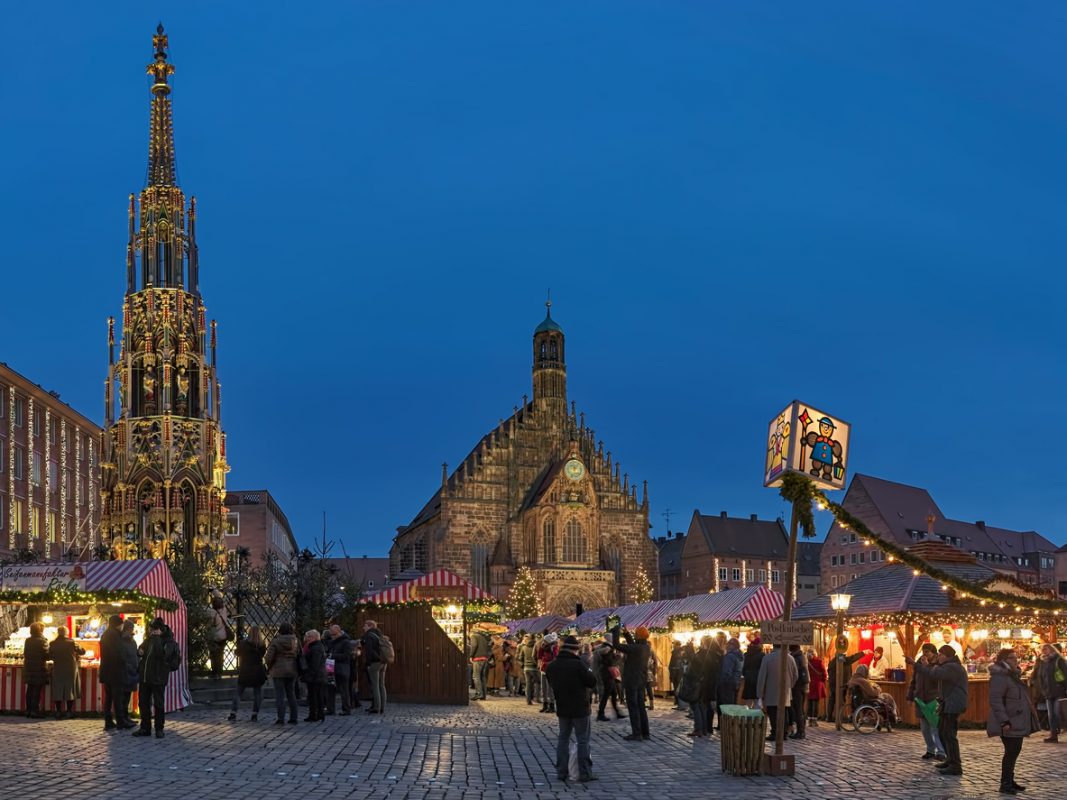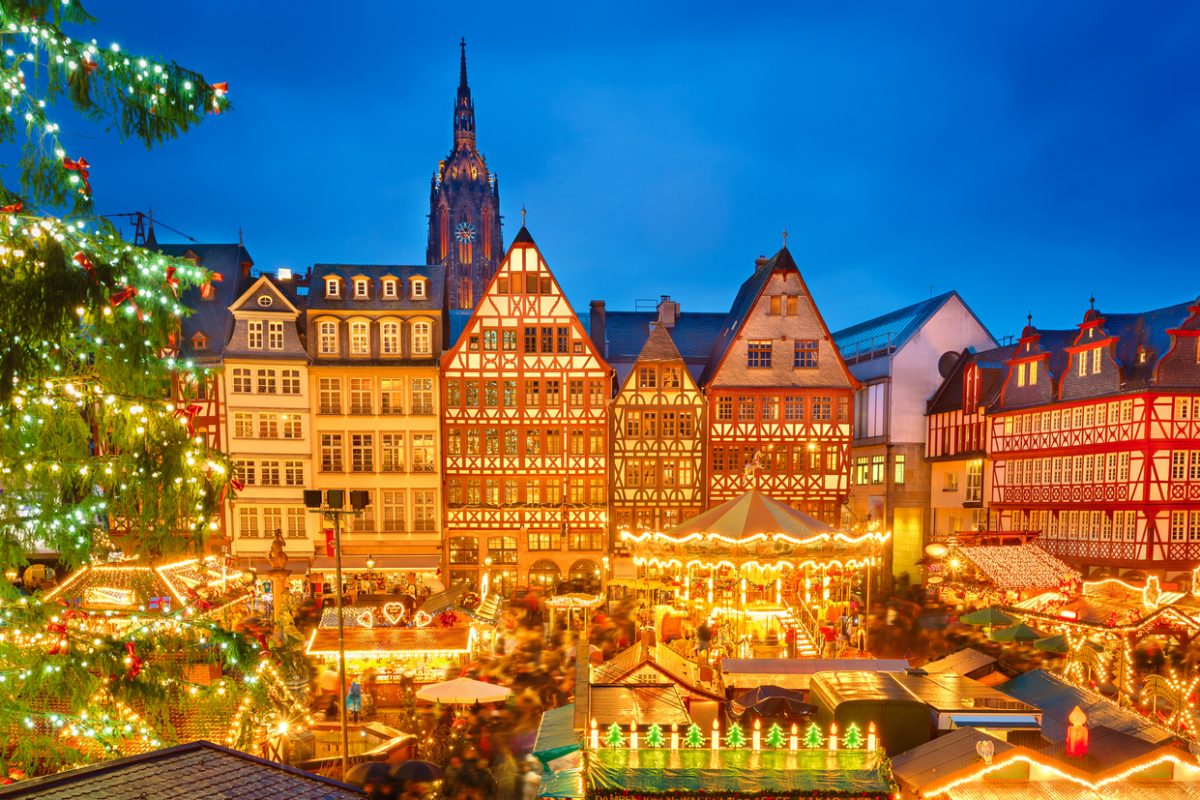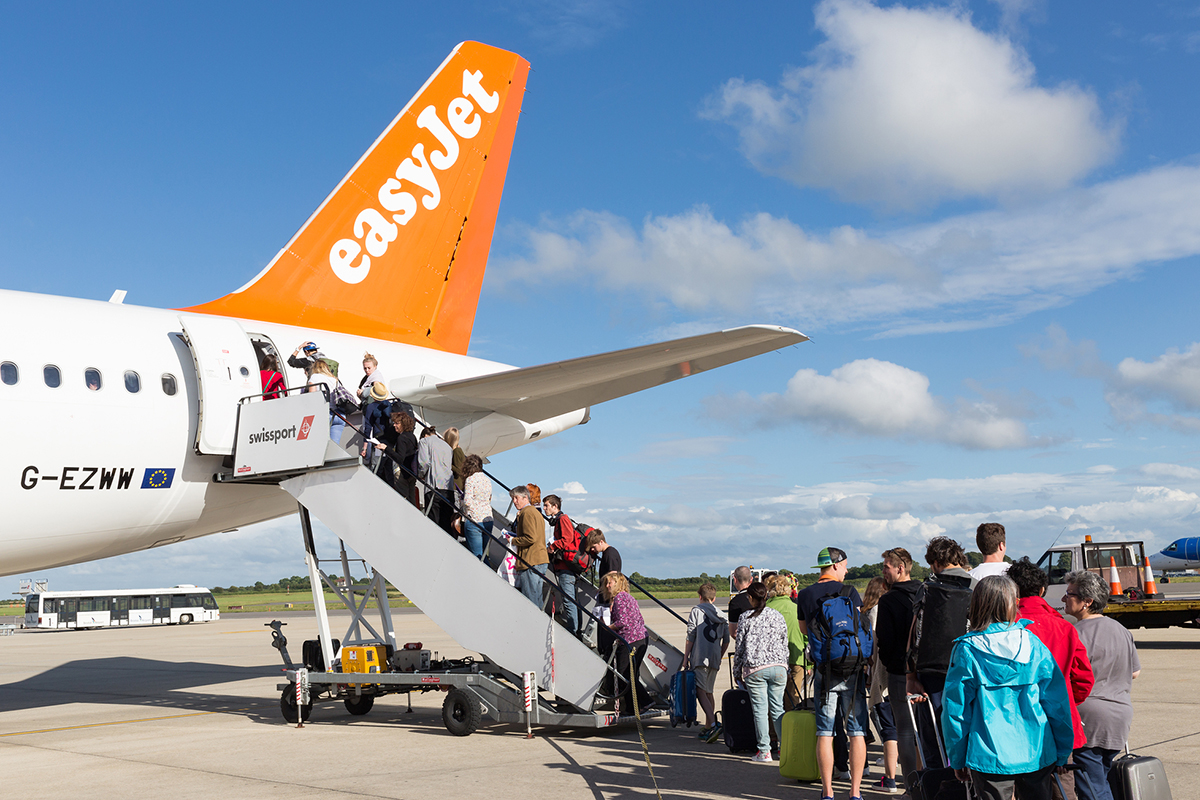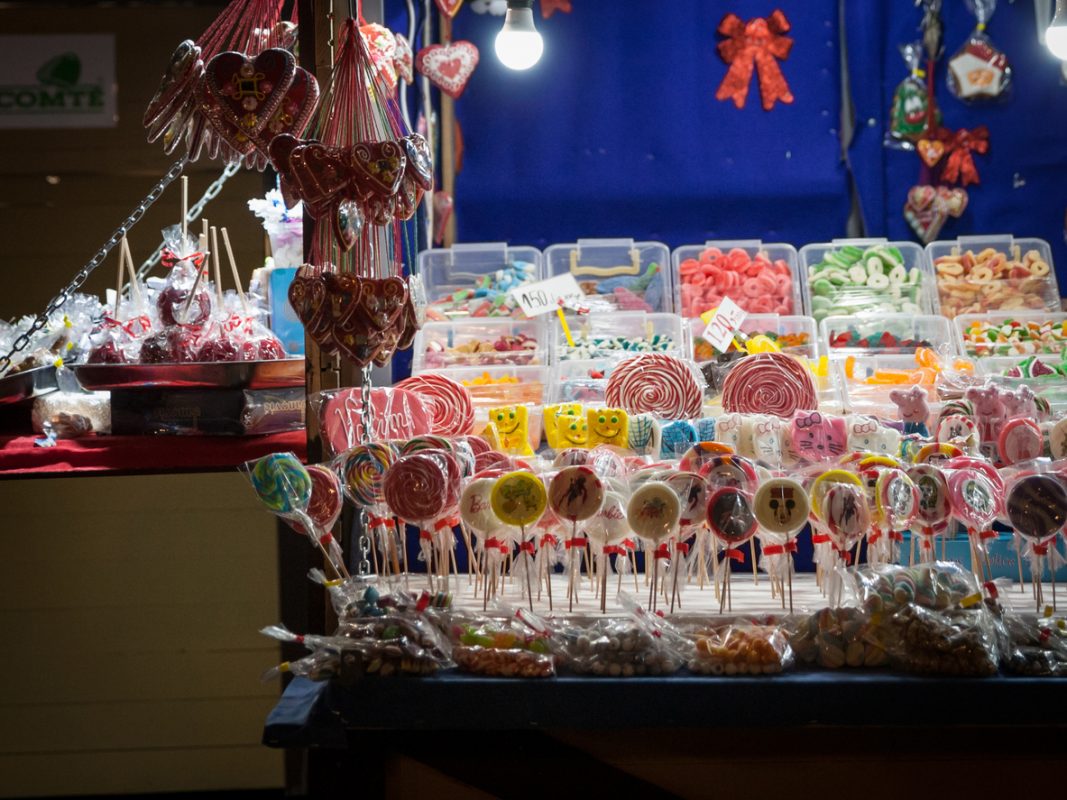Are you looking for the best Christmas markets in Germany? Discover them all in our full guide!
A frost-kissed wind, soft snow underfoot (if you’re lucky!), and the sweet scent of mulled wine – welcome to the world of German Christmas markets, or as the Germans call it – “Weihnachtsmarkt“.
These magical markets are a cherished tradition, steeped in history, going all the way back to the late Middle Ages.
They transform city centres across Germany into winter wonderlands, enchanting locals and tourists alike with their fairytale ambience, festive cheer and an irresistible array of culinary delights.
So, why choose Germany for Christmas markets?
For one, they’ve been perfecting this holiday tradition for centuries, blending old-world charm with modern allure.
Second, their markets offer a unique sensory journey, with each city adding its personal touch to the festive canvas.
Whether it’s the twinkling lights of Nuremberg or the culinary cornucopia of Frankfurt, every market has something special in store.
I’ve spent many a winter exploring the glorious Christmas markets of Germany, and I’ve put all of my experiences and top tips together in this full guide!
What to expect at the Christmas markets in Germany
Imagine walking into a frosty square, bathed in the warm, golden glow of thousands of twinkling fairy lights.
To your left, rows of wooden huts, festooned with garlands and ribbons, showcase handcrafted ornaments, artisanal toys, and an assortment of unique, local handicrafts.
To your right, food stalls waft tantalizing aromas of bratwursts sizzling on the grill, candied almonds roasting, and fresh pretzels baking.
In the air, the comforting scent of Glühwein (mulled wine) fills the air, enticing you to cup your hands around a warm, festive mug.
Definitely among the best Christmas markets in Europe, a German Christmas market is an orchestra of experiences, orchestrated to delight every sense.
Stallholders, clad in traditional attire, greet you with a warm “Frohe Weihnachten” (Merry Christmas) as you meander through the aisles.
Carolers and choirs create a perfect soundtrack to your exploration with classic Christmas tunes wafting through the air.
And there’s the palpable joy that fills these markets — the radiant smiles of children marveling at giant gingerbread houses, the soft laughter of friends sharing a hearty meal, and the hushed awe of onlookers beholding an exquisitely crafted nativity scene.
In short, attending a German Christmas market is like stepping into a Christmas card.
It’s not just a place to shop, but an experience steeped in tradition and communal warmth that encapsulates the spirit of Christmas!
History of Christmas markets in Germany
The tradition of Christmas markets in Germany dates back to the Late Middle Ages.
These festive gatherings initially served a practical purpose, offering townsfolk an opportunity to stock up on food, drink, and essential supplies to sustain them through the harsh winter months.
Over time, these Medieval markets transformed from pragmatic affairs into joyful celebrations.
The first recorded Christmas market was Dresden’s “Striezelmarkt” in 1434, named after the striezel or stollen, a popular fruitcake, that was a speciality of the market.
As the tradition grew from the 15th century, so did the range of goods on offer.
Craftspeople began to sell handmade toys, ornaments, and gifts, adding a festive ambiance to the markets.
Foods associated with Christmas, like gingerbread and mulled wine, became popular stall offerings, enhancing the sensory appeal of the markets.
These markets, often set against the backdrop of town squares and cathedrals, soon came to symbolize the arrival of the holiday season.
The tumultuous periods of the Reformation and World Wars impacted the tradition of Christmas markets, with some markets closing or changing their names to adapt to the social and political climate.
However, post-World War II, as Germany sought to rebuild and recapture its cultural heritage, festive markets experienced a resurgence.
They evolved into the enchanting blend of history, tradition, delicious food, festivity, and community spirit that we know and love today.
These themed markets, with their beautifully decorated stalls, twinkling lights, festive music, and the tantalizing aroma of Christmas treats capture the essence of the holiday season.
Stepping into a German Christmas market is like stepping back in time, a nod to a tradition that has weathered centuries and huge social and political changes, yet continues to bring warmth and joy during the winter season.
Best Christmas markets in Germany
The best Christmas markets in Germany include festivals in Nuremberg, Berlin, Hamburg, Cologne, Dresden and hundreds of smaller cities and towns all over the country. Practically all of Germany comes alive in festive cheer during the season – so let’s dig into where you should visit if you’re visiting Germany this Christmas season!
Nuremberg Christkindlesmarkt, Nuremberg

Venture into the heart of Bavaria and step back in time at the Nuremberg Christkindlesmarkt, a festive spectacle that traces its roots back to the 16th century, making it one of the oldest Christmas markets in Germany.
The market square, set against the stunning backdrop of the Church of Our Lady, brims with nearly 200 stalls, each adorned with red and white striped canopies, reminiscent of candy canes.
The moment you step foot into this yuletide wonderland, you’re welcomed by the tantalizing aroma of the famed Nürnberger Lebkuchen.
This local gingerbread cake, rich in spices and honey, has been a holiday staple since the Middle Ages.
Don’t miss the chance to witness the opening ceremony, where Christkind, an angelic figure adorned in gold, recites a festive prologue from the church balcony.
Striezelmarkt, Dresden
Further east, the German city of Dresden plays host to Striezelmarkt, the oldest Christmas market in Germany that has been a festive holiday season fixture since 1434!
Named after “Striezel“, the earlier form of the delectable Dresden Christstollen (a fruity, nutty bread dusted with powdered sugar), this market celebrates the Stollen Festival on the second Advent Sunday.
In this festival, a gigantic Stollen is paraded through the market and then sliced and sold for charity.
And that’s just the beginning; Striezelmarkt enchants with a forest of Christmas pyramids (including the tallest Ore Mountain step pyramid in the world), what is probably the world’s largest candle arch that you can walk through, a Ferris wheel and a carousel.
Of course, this is amongst the hundreds of stalls selling gifts and festive food!
Christkindlmarkt, Munich
Now let’s journey south to the bustling city of Munich.
The city’s main Christmas market, Christkindlmarkt, takes pride of place in the Marienplatz, bedecked with millions of festive lights.
As you stroll through the festively lit stalls, the air is punctuated with the mellow notes of alpine Christmas carols wafting from the balcony of the Town Hall,.
Located between the imposing New Town Hall and the centuries-old Frauenkirche, this market offers a delightful blend of Bavarian tradition and cosmopolitan charm.
Families with children will find a winter paradise here, with a separate “Heavenly Workshop” where little ones can take part in holiday crafts, bake cookies, or listen to traditional Christmas stories.
Make sure to sample the unique Bavarian delicacies, from the hearty weißwurst (white sausage) to sweet, fluffy dampfnudel.
WeihnachtsZauber, Berlin
Berlin, Germany’s vibrant capital, is home to over sixty Christmas markets, but the one that stands out is WeihnachtsZauber at the Gendarmenmarkt.
Situated in one of the most picturesque squares in the city, framed by the French and German Cathedrals and the Concert House, this market adds a dash of urban sophistication to the festive spirit.
Opening in late November, WeihnachtsZauber beckons art and antique lovers with stalls offering intricate glassware, unique jewellery, and contemporary artwork.
As you roam this glittering market, indulge in gourmet international delicacies, punctuating the familiar scents of traditional German festive fare.
And don’t forget to catch one of the many live performances, from jazz bands to choirs, that grace the grand stage, filling the winter air with melodies.
There’s a small chance of snow; but even if you don’t see the white stuff, it’s still magical!
Frankfurt Christmas Market, Frankfurt

Next up is the sprawling Frankfurt Christmas Market, one of the largest and most attended in all of Germany.
From the moment you step into the Roemerberg in Frankfurt’s historic centre, the atmosphere buzzes with yuletide cheer.
A dazzling 30-meter Christmas tree towers over the square – it’s especially magical when the sun sets and the twinkling lights come alive.
This market is a haven for families, with a traditional merry-go-round, an ice rink, and a miniature railway keeping the younger ones entertained.
Make sure to feast on the famed Bethmännchen, a marzipan treat that’s a local holiday favorite.
Stuttgart Christmas Market, Stuttgart
Stuttgart Christmas Market is a testament to the adage that beauty is in the details.
Each of the nearly 300 stalls in this market is a visual treat, with elaborately decorated roofs that create a sparkling canopy under the winter sky.
Some of these displays are so detailed, they feature entire moving scenes from Christmas stories!
Set amidst the backdrop of Old Palace and spreading out into the city’s shopping streets, the Stuttgart Christmas Market holds an architectural appeal.
Apart from shopping, indulge your taste buds in Swabian treats like Maultaschen (a type of stuffed pasta) and enjoy the various choirs and brass bands that perform on the steps of the Town Hall every evening, adding to the market’s enchanting atmosphere.
Christmas Market, Cologne
With the awe-inspiring Cologne Cathedral standing guard and the Rhine River adding to its scenic beauty, the beautiful market in Cologne is nothing short of a spectacle.
As you approach the market, the cathedral’s twin spires lit up in all their majesty will guide you to the heart of the festivities.
Once there, gaze at the largest Christmas tree in the Rhineland, adorned with 50,000 LED lights.
Meander through the labyrinth of over 150 stalls offering everything from handcrafted gifts to delicious bites.
One of the highlights of this market is the stars – the entire place is draped in a dreamy canopy of stars.
As you sip on the famed ‘Kölsch‘ beer, or bite into the deliciously crispy Reibekuchen (potato pancakes), don’t forget to look up and enjoy the starscape!
Christmas Market, Rothenburg ob der Tauber
If there’s a place where Christmas feels right at home, it’s the medieval town of Rothenburg ob der Tauber.
Stepping into this town is like walking into a Brothers Grimm fairy tale, with its cobblestone streets, timber-framed houses, and majestic town hall.
Come Christmastime, the town square transforms into a festive paradise, with the Christmas Market adding to the charming atmosphere.
One unique aspect of this market is the Rothenburg Christmas Museum. Here, you can delve into the history and evolution of Christmas traditions.
Don’t forget to try the Schneeballen (Snowballs), a local treat made from shortcrust pastry, shaped like a ball, and covered in powdered sugar, a perfect companion as you explore this picturesque market.
Heidelberg Christmas Market
Heidelberg’s Christmas Market is a romantic’s dream come true.
In a prime position in the historic Old Town, this market seems straight out of a romantic Christmas movie.
A unique feature is the ‘Ice Magic’ skating rink on Karlsplatz, offering fantastic views of the Heidelberg Castle, lit up against the night sky.
As you glide across the ice or wander through the maze of beautifully decorated stalls, let the aroma of chestnuts roasting and the taste of the heavenly Heidelberger Studentenkuss (a chocolate praline) uplift your spirits.
Take the funicular up to the castle for a breathtaking panoramic view of the city and the Christmas market below, their lights twinkling like stars fallen to earth.
Leipzig Christmas Market
Leipzig’s Christmas Market is a treat steeped in tradition and historical charm.
Tracing its roots back to 1458, it’s one of the oldest and most beloved Christmas markets in Germany.
Set in the heart of the city against the backdrop of the Old Town Hall, the Leipzig Christmas Market enchants with over 250 twinkling stalls and a giant Saxon spruce Christmas tree.
Children’s eyes will light up at the sight of the historic carousel, a feature unique to this market, with its fairytale figures, nostalgic cars, and even a giant wheel. Some parts of the carousel are 100 years old!
As the delightful scent of Lebkuchen fills the air, don’t forget to sample the Leipzig lark, a sweet pastry that’s a speciality of this market.
Hamburg Christmas Market,
Next, we journey north to the bustling port city of Hamburg.
The city boasts several markets, each with a unique theme, creating a Christmas market trail that’s an absolute delight to explore.
The Historic Christmas Market on the Rathausmarkt, with its traditional crafts and treats, is a crowd favorite.
Here, you’ll find everything from hand-carved nutcrackers to warming Feuerzangenbowle, a potent punch set alight before serving.
For something different, venture to the St. Pauli Christmas Market, an adult’s only Christmas market that epitomizes the infamous district.
It’s an eclectic celebration that encapsulates the unique spirit of Hamburg; it’s a really fun place to visit on a winter city break!
Christkindlesmarkt, Augsburg
The city of Augsburg is known for its Renaissance architecture and rich history, but come Christmastime, it’s the Augsburg Christmas Market that takes center stage.
This enchanting market transforms the Rathausplatz into a festive wonderland, where Christmas lights glisten like a thousand tiny stars against the frost-covered roofs of wooden huts.
A highlight of this market is the Augsburger Engelesspiel (Angel Play). Every evening, twenty-four angels appear on the Renaissance facade of the Town Hall, enchanting the crowd with a magical play.
Whether you’re sipping on a mug of warming Glühwein or biting into a slice of Augsburger Krapfen (a jam-filled pastry), the festive performance of the Angel Play is an experience that truly elevates the magic of the Augsburg Christmas Market.
Christmas Market, Aachen
In the westernmost corner of Germany, the city of Aachen hosts a charming Christmas market.
Gathered around the city’s cathedral and town hall, both UNESCO World Heritage Sites, this market weaves history, tradition, and festive cheer.
No visit to the Aachen Christmas Market is complete without trying the Aachener Printen, a type of Lebkuchen.
With its uniquely spiced flavor and various versions, from chocolate-covered to nut-filled, this gingerbread-like cookie is a must-have.
The market also boasts a diverse range of traditional crafts, making it an ideal place for finding unique Christmas gifts.
Christmas Market, Bremen
Traveling north, Bremen’s Christmas market captivates visitors with its enchanting maritime charm.
The market’s 170 wooden stalls nestle amidst the city’s stunning UNESCO-listed town hall and historic cathedral, crafting a scene plucked from a holiday card.
As you stroll through this picturesque market, keep an eye out for the life-size, traditional Christmas manger with its hand-carved figures.
Bremen’s festive cheer is further enlivened by the Schlachte Magic on the Weser River Embankment, where wooden stalls mimic historic ships and guild houses, offering delicacies from smoked fish to spiced hot chocolate.
Christmas Market, Trier
Our journey now takes us to Germany’s oldest city, Trier. The Christmas Market in Trier unfolds against the stunning backdrop of the UNESCO World Heritage Site, Trier Cathedral.
An ancient city dating back to Roman times, Trier brings a unique character to its Christmas market, making it an unforgettable experience.
One of the highlights of this market is the imposing life-sized, hand-carved nativity scene.
Equally impressive is the range of local Moselle wines on offer, perfect for keeping warm on a cold winter’s evening.
As you meander through the market, the rich aroma of potato pancakes cooking and the sound of carols ringing out from the cathedral’s medieval walls will imbue your visit with a distinctly Trier twist.
How to Get to Christmas Markets in Germany

Transport in Germany is, in a word, efficient.
Whether you’re traveling plane, train, or car, getting to (and between) these festive yuletide markets is effortless!
By Plane
Germany’s major cities – including Berlin, Munich, Frankfurt, and Cologne – all have international airports, connecting them with countries worldwide – Berlin has long-haul connections, whereas many others only link to European cities.
From these airports, you can usually reach the city center – and subsequently, the Christmas markets using local public transportation.
If your chosen market is in a smaller city or town, you might need to fly into the closest airport and take a bus or train to reach your destination.
By Train
Trains in Gemrany are punctual, comfortable, and fast, connecting all corners of the country.
Whisk from one city to another in a matter of hours, savoring the changing landscapes through panoramic windows.
I’d recommend booking tickets online in advance (I use Trainline) to get the best rates.
By Car
If you prefer the freedom of driving, Germany’s Autobahn network connects the whole country.
The Autobahn is famous for having no speed limit, which can seem unnerving, but generally they’re quite safe, provided you’re a confident driver!
By Bus
Are you on a budget?
Long-distance bus companies like FlixBus provide a wallet-friendly alternative to getting around Germany.
These buses connect hundreds of cities and towns across Germany, often offering amenities like free Wi-Fi, power outlets, and onboard restrooms.
I’ve used Flixbus a few times in Germany and Western Europe, and generally, they’re efficient and excellent value.
Tips for Visiting Christmas Markets in Germany

To make your visit as enjoyable as possible, we’ve put together some tips that will help you navigate these festive markets.
Dress for the Weather
German winters can be quite chilly, especially in the evenings when most people visit the Christmas markets – although the chance of snow depends on where in the country you are.
Dress in layers, bring a warm coat and don’t forget your scarf, gloves, and hat.
Staying warm means you’ll enjoy time at the market to the fullest.
Try the Local Delicacies
Each market, each city, and each region will have its own culinary specialities.
If you’re a foodie, there will be plenty to feast on, from warming mugs of Glühwein to regional treats that you won’t find anywhere else.
Bring Cash
Although some stalls might accept credit cards, having cash on hand is best.
Not only will it make transactions smoother, but it’ll also help you avoid potential credit card foreign transaction fees.
Plan Your Visit
While spontaneity has its charm, planning can ensure you get the most out of your visit.
Research the market’s opening hours, check if there are any special events or concerts, and note down any must-see stalls or must-try foods.
Enjoy the Atmosphere
Finally, the best part about visiting a German Christmas market is soaking in the atmosphere.
Take your time to stroll, explore, and savor the sights, sounds, and smells. Remember, it’s not just about shopping – it’s about experiencing the magic of Christmas in Germany.
Christmas Markets in Germany: What to Buy

Looking for a one-of-a-kind gift from German Christmas markets? Here are a few of the things you shouldn’t miss.
Handcrafted Decorations
From glass-blown baubles to hand-carved wooden figures, the Christmas markets in Germany offer a wide variety of unique decorations.
Look out for the famous “smokers” – wooden figures that emit smoke when incense is burned inside them.
Another traditional favorite is the Schwibbogen, a candle-lit wooden arch that typically depicts a winter scene.
Culinary Treats
Treat your taste buds to an array of local and regional delicacies, including Lebkuchen (gingerbread), Stollen (a dense fruitcake), and marzipan sweets.
You could even bring some Glühwein spices home, so you can recreate the warming holiday beverage at home.
Traditional Toys
German Christmas markets are a paradise for children – there are so many incredible traditional toys!
Look for intricately designed nutcrackers, charming wooden pyramids that spin with the heat of candles, and beautiful handmade puppets.
If you’re looking for Christmas presents for your children, grandchildren, nices or nephews, you’ll find an abundance here!
Local Crafts
Each region in Germany has its own artisanal traditions.
You can find beautiful pottery, handmade jewelry, warm woolen clothes, and much more.
These make for perfect Christmas gifts!
Etiquette at German Christmas Markets
While German Christmas markets are places of festivity and fun, keep in mind a few etiquette pointers.
Be Environmentally Conscious
Many Christmas markets in Germany use reusable mugs for their hot drinks to reduce waste.
When you buy a drink, you’ll pay a small deposit for the mug. You can choose to return it for your deposit back, or keep it as a souvenir.
Respect the Stalls
The stalls at the Christmas markets are often small businesses that put a lot of effort into their goods.
Be respectful by not handling items roughly or trying to haggle over prices.
Stay Aware of Your Surroundings
Christmas markets can get crowded, so be aware of your personal space and belongings.
Try not to block walkways while stopping to admire the goods or take photographs.
Pickpocketing does happen at Christmas markets, so I recommend keeping your valuables zipped into pockets or your bag.
Mind Your Manners
Remember to say “please” (bitte) and “thank you” (danke). A little politeness goes a long way and is appreciated by the stall owners.
How to Dress for German Christmas Markets

So, what to wear for the Germany Christmas Markets? Here’s what will keep you warm and comfortable throughout your trip!
Dress Warmly
Germany’s winters can be cold and, at times, quite wet.
Dress warmly so you can comfortably enjoy the festivities.
Think warm sweaters, thermal underlayers, a water-resistant or insulated winter coat, and weather-appropriate footwear.
Layers Are Key
Layering is your best friend during a German winter.
If it’s really cold, start with thermal undergarments, layer on warm sweaters or fleeces, and top it all with a good quality winter coat.
If you get hot, you can always remove a layer!
Don’t Forget the Woolies
Don’t forget a scarf, hat and gloves – and consider thermal socks and even heat packs for your pockets on particularly cold days.
Comfortable Footwear
Cobblestone streets and extended walking periods are common at Christmas markets, so comfortable, sturdy footwear is a must.
Waterproof boots with good grip and warm lining are ideal.
Family-Friendly Features of German Christmas Markets
German Christmas markets are a delight for the entire family. From special attractions for the little ones to child-friendly foods and treats, there’s plenty to keep your children entertained and enchanted here!
Magical Attractions
Many markets feature carousels, ice skating rinks, and even mini Ferris wheels.
Some larger markets host special performances or have dedicated children’s sections with puppet shows and face painting.
Santa Sightings
Don’t be surprised if you spot Saint Nicholas wandering through the market, especially on December 6th, Saint Nicholas Day.
He often hands out treats to the little ones!
Child-Friendly Foods
While you’re enjoying your Glühwein, children can indulge in Kinderpunsch, a non-alcoholic version of the holiday beverage.
Traditional market foods like Bratwurst, pretzels, and sweet treats are generally kid-approved favorites.
Christmas Crafts
Many markets also have stalls where children can try their hand at Christmas crafts, like decorating gingerbread cookies or making candles.
It’s a great way for them to join in the festive fun and take home a handmade souvenir.
Are you ready to visit the German Christmas markets?
Blending festive joy, historical charm, culinary delights, and local craftsmanship, it’s no surprise that tourists flock to Germany’s Christmas markets time and time again.
Whether you’re standing beneath the twinkling lights of a towering Christmas tree, sipping on a warm cup of Glühwein, exploring stalls filled with handcrafted treasures, or simply soaking in the magic of the holiday season, a visit to these markets is a true embodiment of the Christmas spirit.
Each market, with its unique characteristics, paints its own festive picture, inviting you to step into a world where Christmas isn’t just a season but an experience.
So, put on your warmest coat, let the scent of gingerbread guide you, and immerse yourself in the timeless tradition of the German Christmas markets.
Frequently Asked Questions
When do the Christmas markets in Germany start and end?
Most Christmas markets in Germany begin in the last week of November or the first week of December and usually end a couple of days before Christmas. Some markets, like the one in Munich, continue until New Year’s Day. However, dates can vary, so it’s best to check the specific dates for each market beforehand.
What should I eat at a German Christmas market?
There’s a wealth of culinary delights to explore at a German Christmas market. Must-tries include Bratwurst, Lebkuchen (gingerbread), Stollen (fruitcake), and a variety of regional specialities. To drink, Glühwein (mulled wine) is a popular choice.
Can I visit the Christmas markets if I don’t speak German?
Absolutely! While knowing a few phrases in German is always appreciated, many stall owners and locals speak English – the English level in Germany is very high. Most markets also provide information and maps in English.
How accessible are the Christmas markets for people with mobility issues?
Many Christmas markets make efforts to be accessible to everyone, with level entrances and flat ground for easy navigation. However, many markets are held in old city centers with cobblestone streets, which can pose some challenges. Check the accessibility information provided by each market in advance.
Do the Christmas markets get crowded?
Yes, the Christmas markets can get quite busy, especially on weekends and in the evenings. If you prefer a quieter experience, consider visiting on a weekday and during the daytime. If you want fewer crowds, you could check out the Christmas markets in Poland (it’s a wonderful December destination) or Bucharest!
